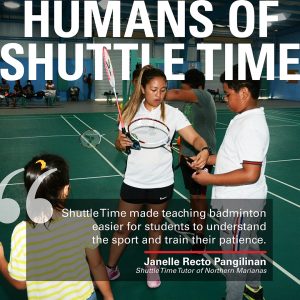The Badminton World Federation’s Humans of Shuttle Time series presents the perspectives of those who work on badminton development at the grassroots level. Janelle Pangilinan, Northern Marianas Badminton Association Shuttle Time Coordinator (and Pacific Mini Games bronze medalist), talks about her journey into badminton and experiences of enhancing badminton opportunities for communities across the country:
I was born and raised in the Northern Marianas Islands on the island of Saipan. My childhood was always about being active, playing tag, dodge ball, etc, with my neighbour. My interest in badminton started in 2011 when I was eleven. Badminton Oceania came to do a summer programme for two weeks at the TSL Sports Complex, Gualo Rai. I didn’t know badminton could be played competitively. I’d always played it as a kid with my neighbours. Once I joined the camp, I realised how much I enjoyed playing it.
𝗥𝗲𝗹𝗮𝘁𝗶𝗼𝗻𝘀𝗵𝗶𝗽 𝗪𝗶𝘁𝗵 𝗕𝗮𝗱𝗺𝗶𝗻𝘁𝗼𝗻
After the camp ended, I started to play badminton almost every day during the summer.
I never played tournaments until after a year of starting the sport. My first tournament is very memorable to me because I won the Women’s C Singles Division. That was when I realised I wanted to get to the A level, and nothing was going to stop me from growing.
𝗪𝗵𝗮𝘁 𝗕𝗮𝗱𝗺𝗶𝗻𝘁𝗼𝗻 𝗠𝗲𝗮𝗻𝘀
Badminton now is a big part of my life. I see how much badminton has grown over the past year and I want to use my knowledge to teach kids. Growing up playing badminton, there weren’t many young people; it was all adults. As I get older I want to see more youth playing the sport because they are the future.
 𝗪𝗵𝗮𝘁 𝗠𝗮𝗸𝗲𝘀 𝗕𝗮𝗱𝗺𝗶𝗻𝘁𝗼𝗻 𝗗𝗶𝗳𝗳𝗲𝗿𝗲𝗻𝘁
𝗪𝗵𝗮𝘁 𝗠𝗮𝗸𝗲𝘀 𝗕𝗮𝗱𝗺𝗶𝗻𝘁𝗼𝗻 𝗗𝗶𝗳𝗳𝗲𝗿𝗲𝗻𝘁
It is a non-contact sport, so you do not have to physically engage with your opponent. It’s also a fast game that helps you build reflexes.
𝗗𝗲𝘃𝗲𝗹𝗼𝗽𝗶𝗻𝗴 𝗕𝗮𝗱𝗺𝗶𝗻𝘁𝗼𝗻 𝗶𝗻 𝘁𝗵𝗲 𝗖𝗼𝗺𝗺𝘂𝗻𝗶𝘁𝘆
Going to schools and teaching Shuttle Time, the first question I always ask is, “Have you ever played badminton or even heard of badminton?” Usually, 70 per cent don’t know what badminton is. Thus, teaching a new sport to students will grow the knowledge of badminton.
After the Interscholastic Sports finished, many schools have been asking us to deliver in their summer school programmes, which shows an increase in its popularity and that schools are enjoying the Shuttle Time programme.
𝗜𝗺𝗽𝗮𝗰𝘁 𝗼𝗳 𝗦𝗵𝘂𝘁𝘁𝗹𝗲 𝗧𝗶𝗺𝗲
Shuttle Time made teaching badminton easier for students to understand the sport. It has influenced public schools into making it an interscholastic sport. This is the first time badminton is being played. Five middle schools and five high schools joined, with more than 100 participants.
𝗟𝗲𝘀𝘀𝗼𝗻𝘀 𝗙𝗿𝗼𝗺 𝗦𝗵𝘂𝘁𝘁𝗹𝗲 𝗧𝗶𝗺𝗲
The biggest lesson from Shuttle Time is being patience. Not many students can get it right away, they are the ones that who need the most attention. For those that do get it, you’ve got to work with positive reinforcement so that they know they are doing well and making progress.






